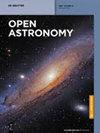11-year dynamics of coronal hole and sunspot areas
IF 0.5
4区 物理与天体物理
Q4 ASTRONOMY & ASTROPHYSICS
引用次数: 1
Abstract
Abstract The paper presents study the 11-year dynamics of solar activity on the basis of new observational material on coronal holes (CHs) and sunspots in the period from May 13, 2010 to May 13, 2021. We used the Heliophysics Event Knowledgebase (HEK) to obtain information on CHs areas. For 11 years of observations, we processed about 18000 CHs. Slightly more than 8000 are polar, the rest are nonpolar CHs. The statistical volume of the presented material is quite extensive and gives grounds for the study of the dynamics of different types of CHs during the cycle. Our research has shown: in the 24th solar activity cycle, the South led for polar CHs and the North led for nonpolar ones. We established a relationship between the number and area of CHs and the phase of the solar cycle. The number and daily total area of polar CHs increases at the minima of solar activity and decreases at the maximum of the cycle. This is consistent with the general concept of polar CHs as the main source of the solar dipole magnetic field. An asymmetry in both the number and areas of polar coronal holes in the northern and southern hemispheres is observed. It is shown that the areas of nonpolar CHs change quasi-synchronously with sunspot activity, which suggests a physical connection between these two phenomena.日冕空洞和太阳黑子区的11年动力学
摘要本文利用新的观测资料,研究了2010年5月13日至2021年5月3日期间太阳活动的11年动力学。我们使用太阳物理事件知识库(HEK)来获取有关CHs区域的信息。在11年的观测中,我们处理了大约18000个CH。略多于8000个是极性的,其余是非极性的CH。所提供材料的统计量相当广泛,为研究循环过程中不同类型甲烷的动力学提供了依据。我们的研究表明:在第24个太阳活动周期中,南方主导了极性CH,北方主导了非极性CH。我们建立了甲烷的数量和面积与太阳周期相位之间的关系。极地CH的数量和日总面积在太阳活动的最小值时增加,在周期的最大值时减少。这与极性甲烷作为太阳偶极磁场主要来源的一般概念一致。在北半球和南半球观测到极地日冕空洞的数量和面积不对称。结果表明,非极性CH的面积与太阳黑子活动准同步变化,这表明这两种现象之间存在物理联系。
本文章由计算机程序翻译,如有差异,请以英文原文为准。
求助全文
约1分钟内获得全文
求助全文
来源期刊

Open Astronomy
Physics and Astronomy-Astronomy and Astrophysics
CiteScore
1.30
自引率
14.30%
发文量
37
审稿时长
16 weeks
期刊介绍:
The journal disseminates research in both observational and theoretical astronomy, astrophysics, solar physics, cosmology, galactic and extragalactic astronomy, high energy particles physics, planetary science, space science and astronomy-related astrobiology, presenting as well the surveys dedicated to astronomical history and education.
 求助内容:
求助内容: 应助结果提醒方式:
应助结果提醒方式:


